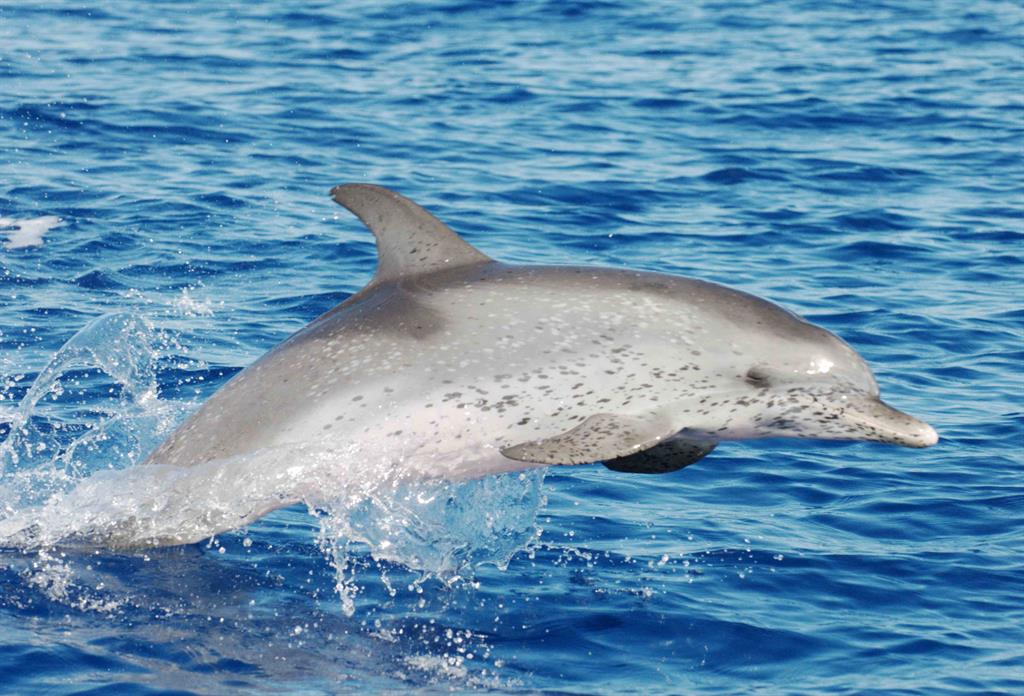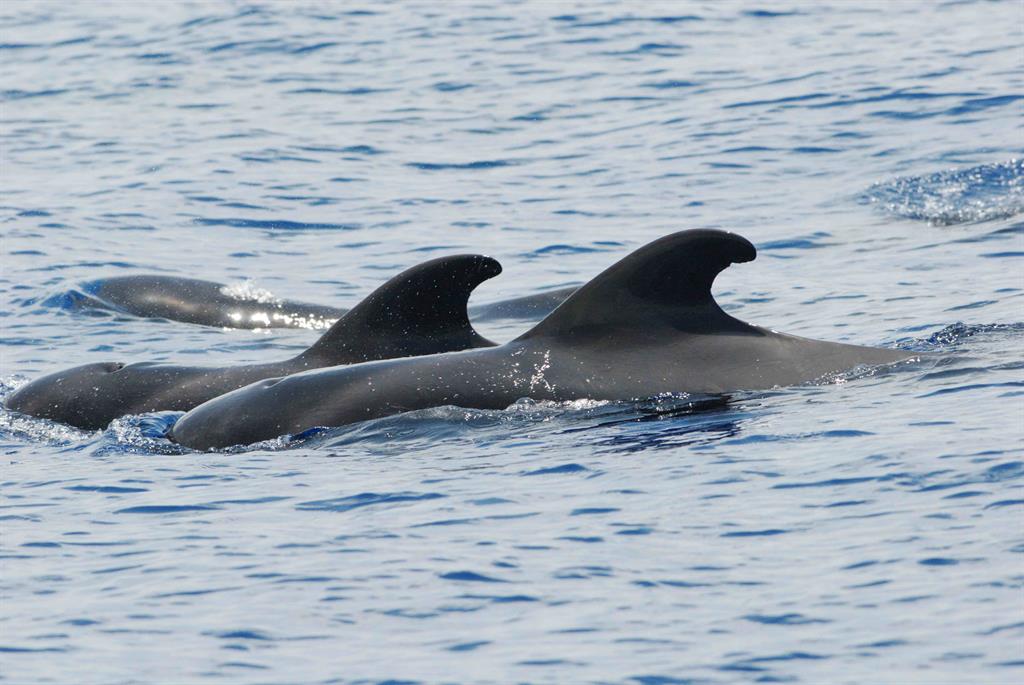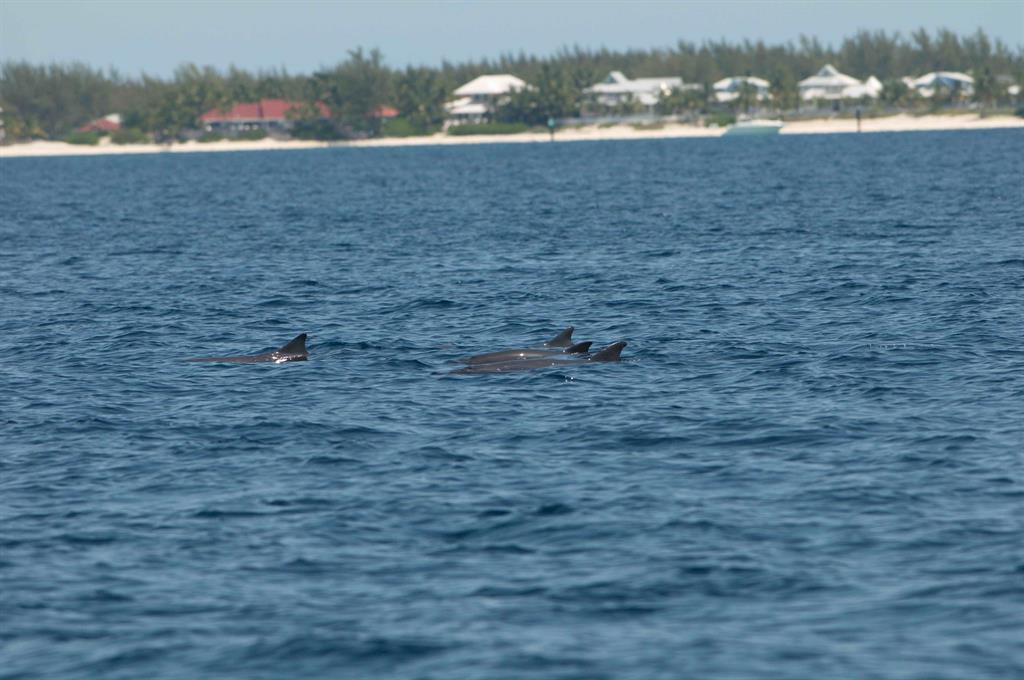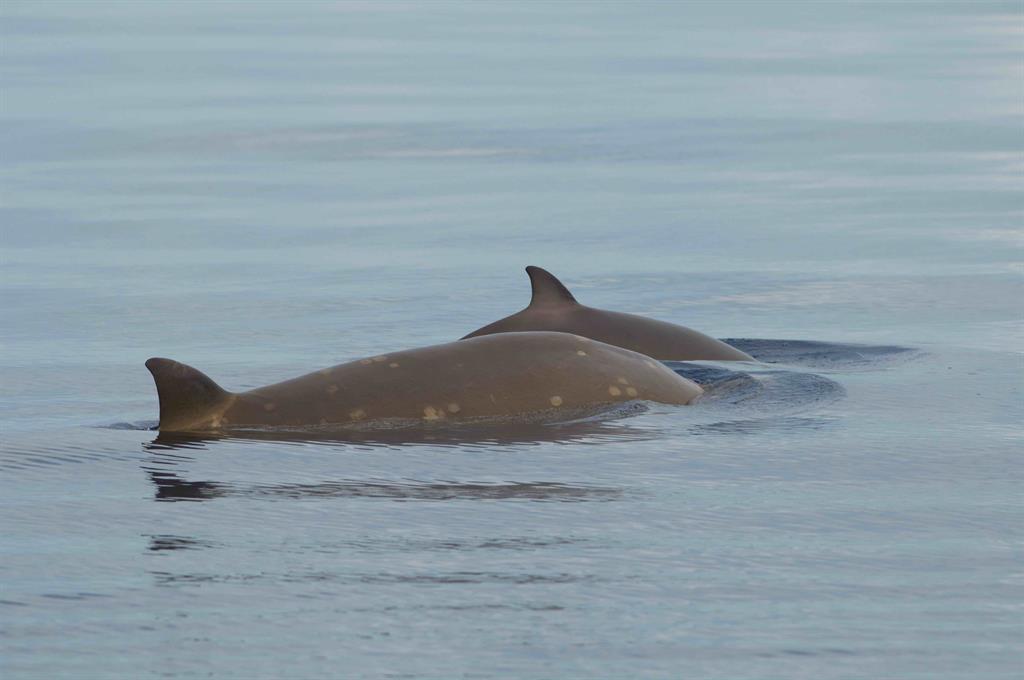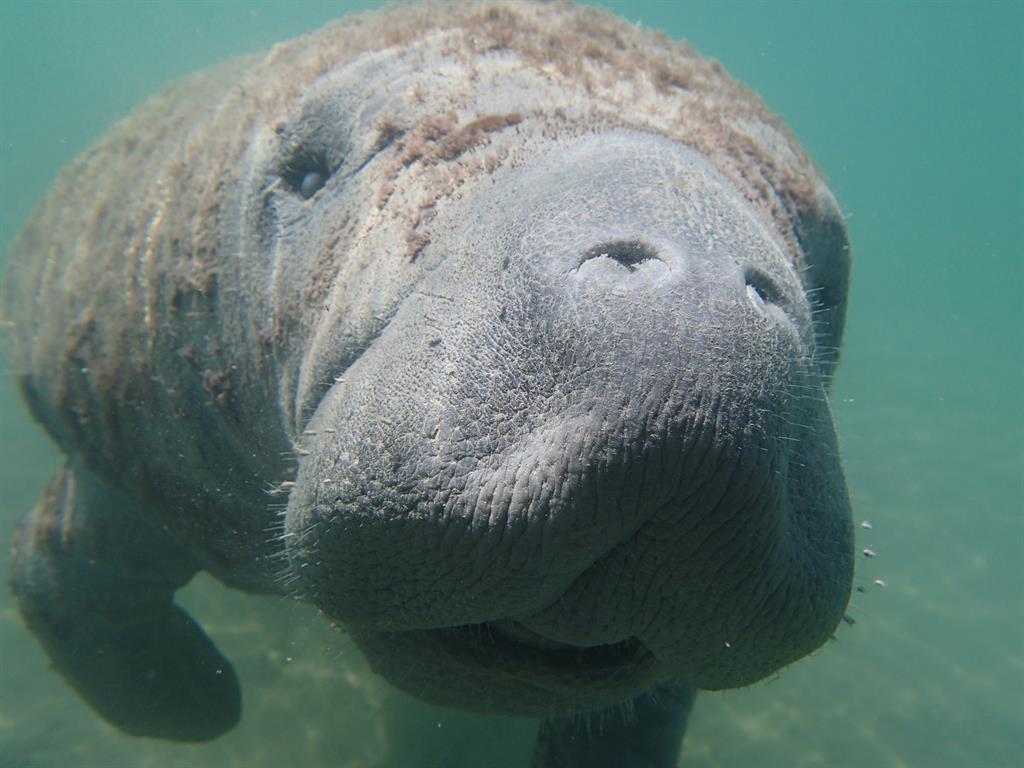|
|
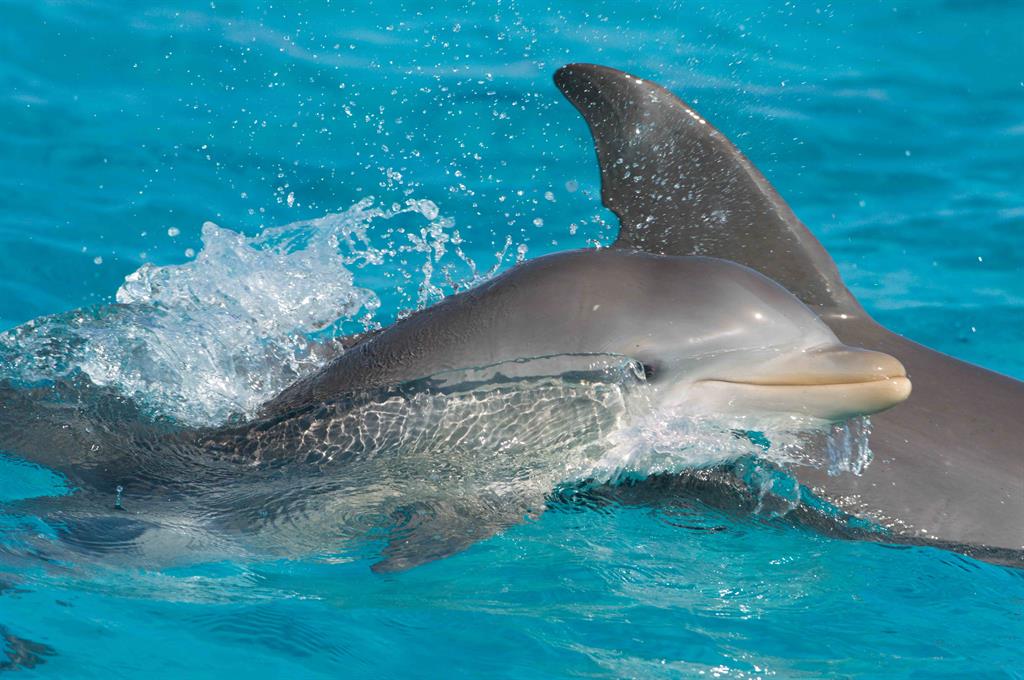
|
|
Bottlenose dolphins
(Tursiops truncatus), formerly called Atlantic or common bottlenose dolphins, are the most common marine mammals seen in Abaco, Bahamas. It should be noted, however, that there are at least two distinct “breeding populations” or “ecotypes” of this species: coastal bottlenose dolphins that inhabit the shallow waters of Little Bahama Bank; and, oceanic bottlenose dolphins found in the deep waters surrounding Abaco. These populations diverged genetically several hundred thousand years ago and have since developed different physiological adaptations to their respective marine environments. The coastal ecotype is smaller in length reaching just over 8 feet and has relatively larger pectoral fins and dorsal fin which helps them to maneuver more readily around rocks and reefs to catch fish, and to regulate their internal body temperature (the temperature of the shallow Bank waters fluctuates much more than the deeper Atlantic Ocean). The coastal dolphins do not travel much beyond the barrier reefs of Abaco; and, while most individuals remain resident to the same area such as the Sea of Abaco for their lifetime, others are known to range across Little Bahama Bank. The deeper diving oceanic ecotype can reach 10 feet or more in length and can remain at depth for longer than their coastal cousins due to their ability to store more oxygen in their blood. They are usually seen in larger groups and appear to have a more extensive range. Photographs of individual oceanic bottlenose dolphins have shown movements between Abaco, Bimini and Exuma Sound.
Watch a cool video we made about them here.
Bottlenose Dolphins of the Bahamas from Conch Salad TV on Vimeo.
|
|
|
|
|
|
|
|
Atlantic spotted dolphins
(Stenella frontalis), are the more frequently seen of two different species of spotted dolphins found in the Abacos; the other species is the pan-tropical spotted dolphin (Stenella attenuata). Spotted dolphins are not born with spots, but actually accumulate them as they mature, becoming quite mottled-looking as adults. Hence, young spotted dolphins are often confused with bottlenose dolphins, and sometimes the two species will interact, which adds to the confusion. Spotted dolphins have a more slender snout, and although they can almost reach the same length as bottlenose dolphins, they have a smaller girth and thus body weight. Atlantic spotted dolphins are a year-round resident species in the Abacos. Individuals photo-identified 20 years ago can still be seen ranging along the eastern and southwestern coasts of Abaco. They are commonly seen in groups of 20-50 dolphins in the oceanic waters where they feed on flying fish and squid, and rarely venture on to the bank. However, in the northwestern part of Little Bahama Bank this species can regularly be found along the western edge of the banks during the daytime where they come to rest and socialize.
|
|
|
|
|
|
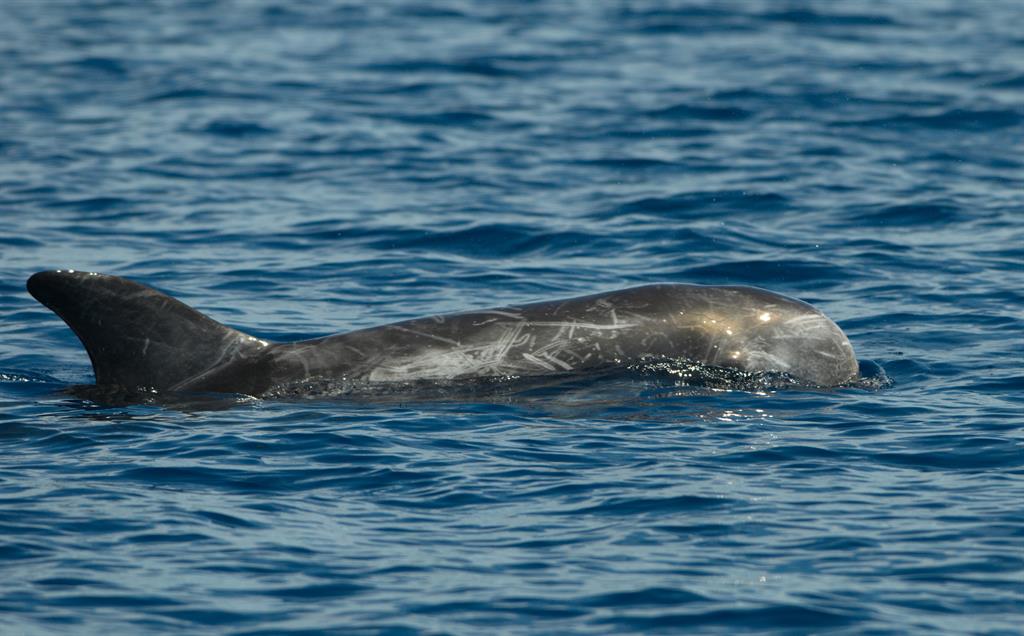
|
|
Risso’s dolphins
(Grampus griseus) are large light grey dolphins that can reach over 13 feet in length, and have a relatively tall, dark dorsal fin. Adults are typically covered with overlapping white scars caused by the teeth of their con-specifics making them look quite battered. They have a rounded head, lacking a beak, but have a deep vertical crease down the center of the forehead. As they mature, their forehead becomes prominently white, making them one of the easiest species to recognize at sea. Risso’s dolphins are commonly seen in the Abacos each winter and spring, primarily on the Atlantic side of the islands. It is unknown where these groups range the rest of the year, but some individuals have been seen off Abaco repeatedly over the years.
|
|
|
|
|
|
|
|
Short-finned pilot whales
(Globicephala macrorhynchus) can grow to 18 feet in length and weigh over 5,000 pounds, with males being significantly larger than females. They have a bulbous forehead with no perceptible beak, a faint grey diagonal stripe behind each eye and a faint grey “saddle” behind and below the dorsal fin. The rest of their body dorsally is jet black, which prompted whalers to name them “blackfish”, a term that also includes three other species known from The Bahamas (melon-headed whales, pygmy killer whales and false killer whales). Pilot whales can readily be distinguished from the other blackfish species by the position of their large, broad-based dorsal fin, which is set quite far forward on their body. They live in matrilineal pods consisting of up to three generations of related females and their offspring. On calm days, they can be seen in tight groups lying abreast, resting at the surface for hours. Pilot whales are seen in The Bahamas year-round but are more common during the spring and summer months, and are not a resident species. Pilot whales found in The Bahamas appear to have large ranging patterns; pilot whales tagged in The Bahamas have travelled as far north as North Carolina suggesting they are part of the US southeast population.
|
|
|
|
|
|
|
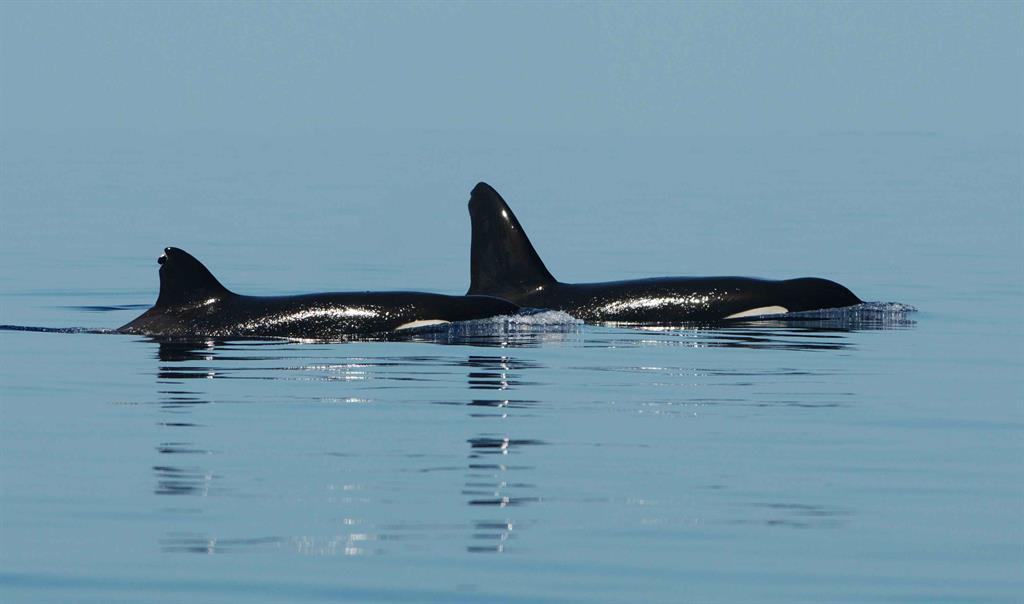
|
|
Killer whales
(Orcinus orca), or orcas, are probably the easiest cetacean species to recognize at sea due to their striking black and white pigmentation patterns. Orcas are the largest member of the oceanic dolphin family, with males reaching 30 feet in length and weighing 8 tons, while females reach only 23 feet and weigh 4 tons. The most conspicuous feature of these whales is the dorsal fin, which can grow over 6 feet tall in adult males. These top predators are found in all the world’s oceans but are more abundant in higher latitudes where prey resources are more plentiful. Orca pods are seen almost every year in Abaco usually in the late spring and summer, including one group that has returned repeatedly over 15 years. While they have been observed feeding on dolphins and dwarf sperm whales around Abaco, they are most likely in the area in response to prey migrations such as tuna, and remain in the area for 1-2 days only. Oracas in Andros August 2019
|
|
|
|
|
|
|
|
Dwarf sperm whales
(Kogia sima) are the most common marine mammal seen in the oceanic waters around Abaco. Adults reach only 8-9 feet in length, and the dorsal fin is set mid-way down the body and is falcate or triangular in shape, so they can easily be confused with dolphins at a distance. Pygmy sperm whales
(Kogia breviceps) are slightly larger reaching up to 10 feet in length, but the dorsal fin is smaller and set further back on the body, making it easy to confuse this species with beaked whales. These small whales are often found solitary or in small groups in extremely deep water environments, and have adapted numerous ways to avoid predators such as killer whales. Both species have counter shading, being dark grey dorsally and white on the underside making it more difficult to see them from the surface or from below. They also have a white line of pigmentation on each side behind the head, known as a false gill, making them look like a shark. When threatened, they are able to expel ink which they have ingested from squid, their primary prey, creating a dark cloud in which they can escape. Their behavior while at the surface is very cryptic, and they are most typically seen logging, or lying motionless. When a vessel approaches them, they dive and swim away, making them very difficult study subjects!
|
|
|
|
|
|
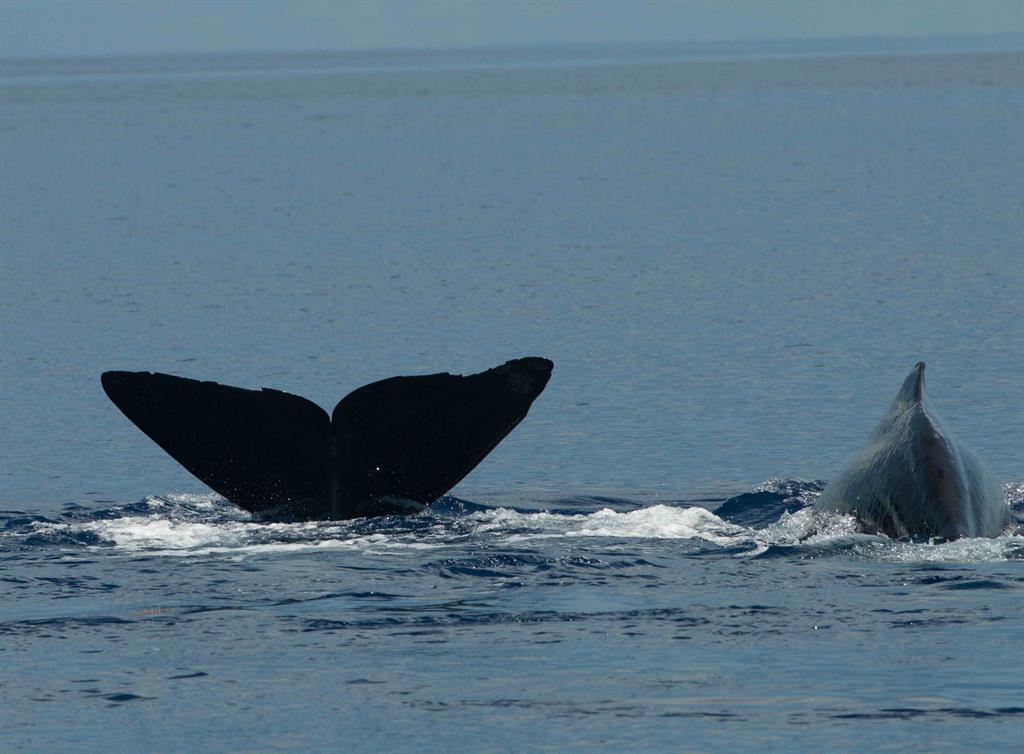
|
|
Sperm whales
(Physeter macrocephalus) have dark brown, wrinkled-looking skin and an enormous square-shaped head that comprises one third of their total body length. Males can attain a body length of 60 feet while females are considerably smaller, reaching 35-40 feet in length when mature. Their single blowhole on the left side of the head at the front causes a distinctive “blow” which angles to the left and forward. Sperm whales dive to great depths (>3,000 feet) for more than an hour at a time where they feed on large squid, their primary prey. When a sperm whale prepares to dive, it raises its massive tail, allowing researchers to photograph the distinctive pattern of notches in the trailing edge of the tail flukes to aid in monitoring individuals over time. Adult females form nursery groups which are long-term social units made up of related females that can be found in The Bahamas year-round. Some of these females have been repeatedly seen in The Bahamas over the past 20 years. Mature males frequent the islands only during the winter breeding season and spend the rest of the year feeding in more productive Arctic waters.
|
|
|
|
|
|
|
|
Blainville’s beaked whales
(Mesoplodon densirostris) are found in all the world’s tropical and temperate waters and are one of the most common species seen near Sandy Point, Abaco, where BMMRO is based. These medium-sized whales reach 14-16 feet in length, are brownish-grey in color and have a spindle-shaped body that tapers at both ends. They have a small dorsal fin found almost two thirds of the way back along their body and a well-defined beak or snout, which usually breaks the water first as the whale surfaces to breathe. This species has only two teeth located in the lower jaw which erupt above the gum line in males when they become sexually mature, and are used as “tusks” during combat with other males and not for feeding purposes. Adult males look quite bizarre as they often have clusters of stalked barnacles growing on their protruding “tusks”. Older whales have numerous white oval scars caused by cookie cutter sharks and multiple paired linear scars caused by the “tusks” of their con-specifics. Each whale’s unique scarring pattern has allowed BMMRO to track individuals over multiple generations. This work has revealed that there are small, resident subpopulations of Blainville’s beaked whales inhabiting the deep submarine canyons in The Bahamas. This unprecedented long-term study of a deep-diving, cryptic whale is recognized globally for its importance in increasing knowledge of the natural life history of this species. Watch a great video we made about them here.
|
|
|
|
|
|
|
|
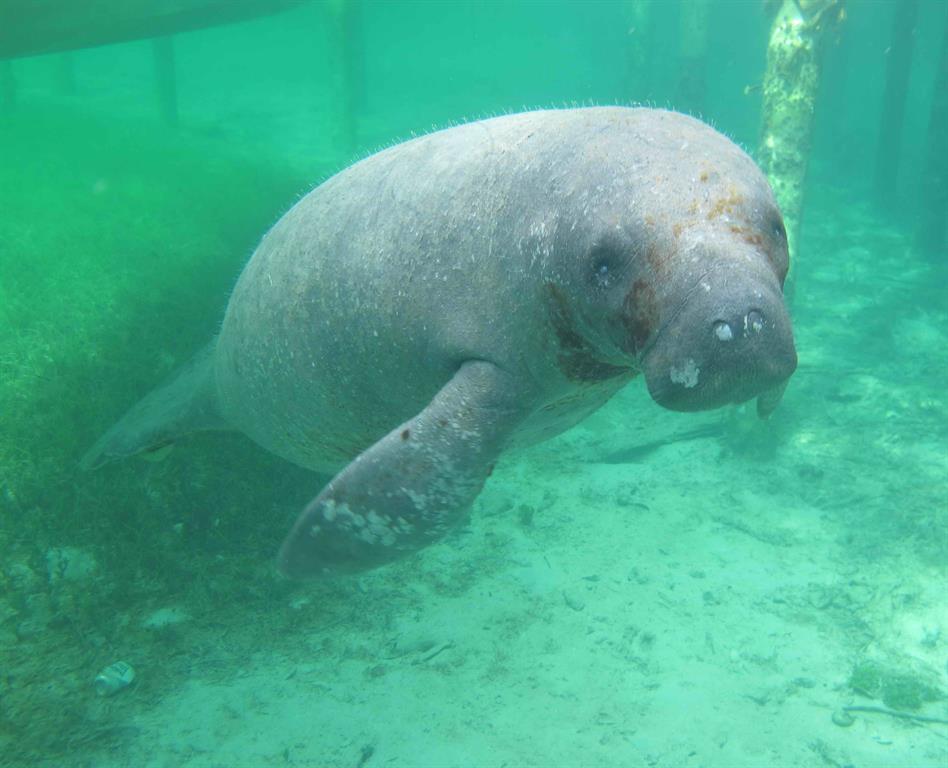
|
|
The West Indian Manatee (Trichechus manatus) consists of two subspecies: Florida manatee and Antillean manatee, both of which can be found in The Bahamas, although only the Florida subspecies has been documented here recently.
Florida manatees (Trichechus manatus latirostris) are found in the southeastern United States, and mostly in Florida but as the population has increased in parts of their range, individuals are dispersing and venturing across the Florida Straits to The Bahamas and Cuba. Although the number of manatees in The Bahamas has increased in recent years and they are even breeding locally, they still remain quite rare here, with only about 20 manatees currently in the entire Bahamian archipelago. That said, three of these are often seen in Abaco. Florida manatees inhabit salt, fresh or brackish waters and feed on marine, estuarine, and freshwater vegetation. Although food is plentiful for manatees in The Bahamas, fresh water may be a limiting resource. Despite this, manatees do not need our help to survive here (or anywhere). BMMRO has been working with the Bahamas Department of Marine Resources to increase awareness about how people should behave around manatees to increase their chances of survival in The Bahamas. Appropriate “Manatee Manners” are (1) Do not feed them; lettuce lacks the nutrition that that they need and is readily available in our abundant sea grass beds. (2) Do not give them water to drink; they are incredibly resourceful and are capable of finding even in smallest fresh water source. By providing them food and water, we are encouraging them to spend time in marinas and harbors where they will eventually be hit by a boat. (3) Please respect their space and do not touch, chase or follow them. Despite their gentle demeanour, they are large animals (adults reach about 10 feet in length and weigh between 800 and 1,200 pounds) that can move very quickly when disturbed and you can get hurt. So please mind you manatee manners and let’s keep wild animals wild!
Watch this video about a mother-calf pair of manatees in the Bahamas that were temporarily rescued and then released.
Manatees of The Bahamas from Conch Salad TV on Vimeo.
|
|


